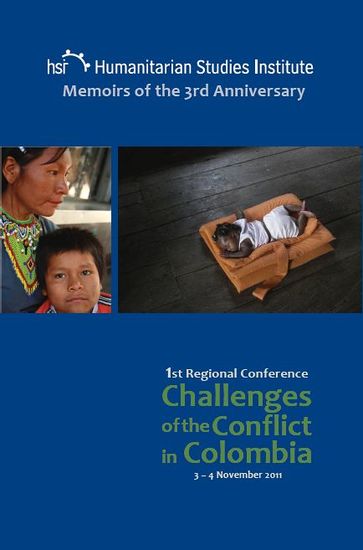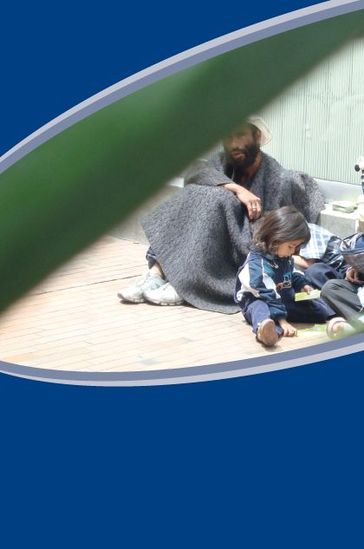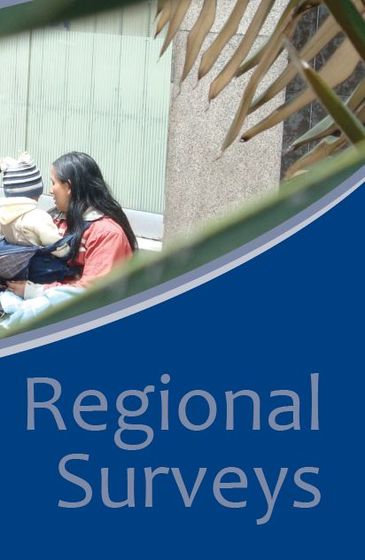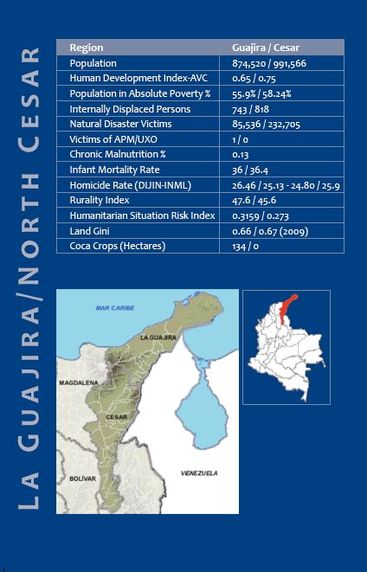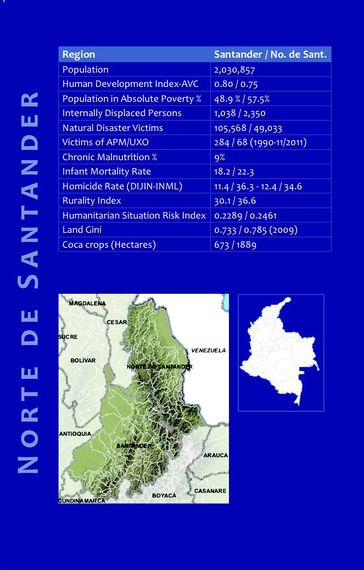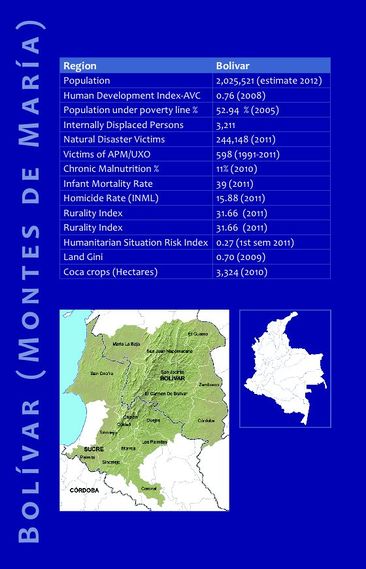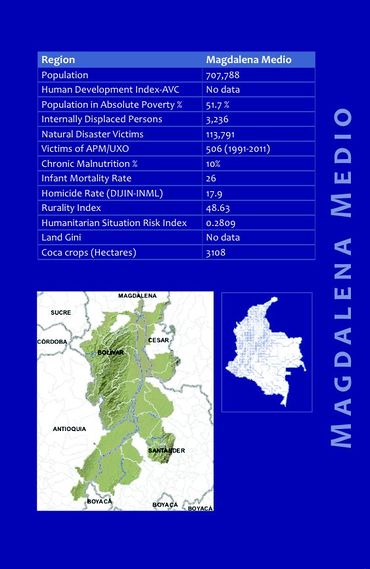Memoirs of the 3rd Anniversary
De iMMAP-Colombia Wiki
These Memoirs were developed by the Humanitarian Studies Institute
allies. Compiled and edited by David Alejandro Schoeller-Díaz. Maps
and data provided by the United Nations Office for the Coordination
of Humanitarian Affairs UNOCHA – Colombia.
The HSI was established in 2008, with the objective of creating links
between Universities, NGOs and UN System Agencies, given the
demonstrated potential for research and training that exists among
local actors in order to improve quality of Humanitarian Action.
These Memoirs can be downloaded from the HSI Website at:
www.colombiassh.org/reh/memoirs3anniv
The Humanitarian Studies Institute (HSI) 2012.
Cover page photo: La Calle sonríe by Fabián Garzón Bustos
Interior photo: Atrás del matorral by Mario Barrero
1st Humanitarian Photography Contest.
Photo stream available in: http://bit.ly/McGA1W
Suggested citation:
Humanitarian Studies Institute (HSI) (2012). 1st Regional Conference.
Challenges of the Conflict in Colombia. 3 and 4 November 2011.
Bogotá: HSI.
Feedbacks and comments are welcome, and should be sent to:
iehinternacional@gmail.com
The Humanitarian Studies Institute would like to express its
gratitude for the financial support of the Canada Fund for Local
Initiatives (CFLI)
On the part of the Office for the Coordination of
Humanitarian Affairs (OCHA), I would like to congratulate
the Humanitarian Studies Institute upon the celebration
of its 3rd Anniversary. HSI has been an important initiative working
towards the integration of humanitarian actors with academics
across Colombia in the areas of training, advocacy and research.
These Memoirs compile the results of a meeting of experts from
regions throughout Colombia, including NGO workers, public
officials from the Ombudsman’s Office, Agency personnel and
researchers, who came together to share their experiences in the
field. These types of meetings are invaluable for the humanitarian
community in Colombia, where the humanitarian situation
frequently tends to be out of public view, and opportunities
to share experiences widely are few. We sincerely hope that
these types of efforts will continue on the part of HSI and the
participants in the event in order to help save lives and reduce
the suffering of millions of Colombians who face the difficulties of
the country’s internal armed conflict and the effects of frequent
natural disasters.
With best wishes for continuing success,
María José Torres
Head of Office
Office for the Coordination of Humanitarian Affairs (OCHA)
Colombia, Technical Secretariat of the Humanitarian Studies
Institute
So… what’s next?
Many efforts are underway to address, confront and transform
the conflict in Colombia. From the highly publicized institutional
ones to those that occur almost invisibly in neighborhoods, villages
and communities aimed at improving coexistence between
neighbors. Others, from diverse civil society sectors, seek to position
their concerns and perspectives in the public arena in order to
mobilize community groups and affect policy. Unfortunately, many
efforts of this type are unknown or invisible simply because they
don’t occur in the epicenter of national decision-making, don’t fit in
the agendas of those who may finance them, or aren’t documented
and shared with the community, in our case, the humanitarian one.
In this context, these Memoirs, consolidated by HSI with much
effort, are one more contribution to advance the aspirations of
the Colombian people for a transformation of the armed conflict.
But how do these Memoirs contribute? And from here, what
might happen? I just want to note three issues that motivated this
gathering of speakers, stories and analysis. The discussion on these
issues may spur a reflection on our institutional practices, and thus
shine light on our future work.
In the first place, these Memoirs stand as evidence. This term is in
such vogue in our context that its meaning is often eroded. With this
text, regional representatives, national and international analysts,
participants, researchers, compilers, and all the collaborators of this
event and its results have become witnesses of what happened and
also of what was affirmed and understood. It’s worth remembering
that these Memoirs emerged in a historical moment after eight years
during which the existence an armed conflict was denied. Though
we can’t say this is the only written material on these subjects in
the aftermath of such era of denial, we can affirm that it stands out
as the product of wide participation of civil society and communitybased
organizations. For HSI, the result is not only a reliable
resource, but also one worthy of systematization and distribution.
Being witnesses of this event better equips us to be more attentive
observers of what happens in the country, especially, as said before,
those things that receive limited attention in the epicenter and don’t
appear as often in the newspapers or newscasts, yet are daily bread
in the country’s periphery. An exercise like this sets a precedent for
more participatory and inclusive discussions.
In second place, the experience of the “Challenges of the Conflict
in Colombia” Conference reveals a shift driven by many sectors of
Colombian society. I’m speaking about the sense of unity reflected in
this two-day exercise, as well as many more compiling the analysis.
It’s important to note that this concept of unity does not equate
to homogeneity, but instead to a diversity of perspectives and
alternatives to approach the conflict in Colombia. Being a member of
an organization focused on children and with strong community ties,
I’ve recognized that participation is nonnegotiable and decisive to
change the culture, structures and practices of a society in crisis. For
HSI and its partners, it’s very important to recognize the institutions,
experts and interns of the humanitarian field. Nevertheless, such
recognition is more valuable if their work is strongly linked to the
base of the community, which on a day-to-day basis experiences the
limitations and vulnerabilities, risks more than others, suffers and
cries. Transposing this diversity of perspectives into the Memoirs
(for the most observant of the text) is a paramount commitment,
because a black-and-white portrayal of the world is intolerable for
those who learn to be inclusive and recognize the value of diverse
perspectives.
Finally, these Memoirs are meant to propel humanitarian
work by enriching our agenda. In many social research projects,
systematization exercises have fallen in the trap of further advancing
the positioning of institutional postures and/or publishing
achievements, rather than generating deep reflections, taking
advantage of lessons, and throwing them in a race to be learned
and incorporated into the practices of private and public life.
The analysis of actors, factors and vulnerabilities-capabilities,
as well as the accumulation of conclusions throughout the text,
is perhaps the most illustrative part. It’s useless to write only to
make history, only to leave a track, or show that one tried one’s
best. We write because a commitment is made for change and
transformation. When Colombians write their Memoirs, such as this
one, we are reading of ourselves in the present, but inevitably, as
we turn the pages, images emerge of how the future could turn,
whether we act or not. These Memoirs assert loudly that the conflict
in Colombia is and will remain what Colombians and their individual
and collective efforts want it to be. If we want something else, let
us learn from the past and present. For HSI, it’s clear that research
activities are a guide for progress and development, as long as their
findings are incorporated into everyday life in institutional practices,
and the work of social structures. Isn’t this a goal to pursue? Isn’t it
an agenda for our work and projection?
So... this is what follows, and on behalf of the Humanitarian
Studies Institute, we hope to have the intent, resources and
commitment of its members to: continue to create experiences like
this, contribute to a better understanding of humanitarian practice
in our context, and tirelessly explore possible ways to continue to
improve, change, transform what we have, into something better
for the country.
Eng. Giovanny Cruz G
National Coordinator of Humanitarian and Emergency Affairs
World Vision Colombia
President of the HSI Board of Directors
The Humanitarian Studies Institute (HSI) represents a joint
effort of United Nations agencies, NGOs and universities to
close the gap between the humanitarian community and
academia. To accomplish this goal, HSI works via three pillars:
advocacy, capacity building and research. As part of its advocacy
strategy, HSI promotes thematic events to examine humanitarian
crises, advance joint analysis of the humanitarian impact of
conflict-related issues and natural disasters, and disseminate the
framework for humanitarian action.
HSI expresses its sincere gratitude to the constructive
contributions of persons from academic institutions, civil society
organizations, NGOs and international organizations that joined
us from across Colombia. This includes organizations as varied
as Universidad del Sinú, Universidad Pontificia Bolivariana de
Montería, Oxfam, Corporación Nuevo Arcoíris, Comisión de Vida,
Justicia y Paz de la Arquidiócesis de Cali, Cocomasia, Diócesis
de Soacha, SAT functionaries of Defensoría del Pueblo, Fedes,
Programa de Desarrollo y Paz del César, and Fundación Montes
de María, among many others.
Sumario
Introduction
The First Regional Conference: Challenges of the Conflict in
Colombia was envisioned as an integrated discussion and joint
analysis on the conflict and humanitarian crises in Colombia, with
an emphasis on their territorial dimensions. Capitalizing on HSI’s
the three-year trajectory joining institutional efforts and bridging
gaps in knowledge, the Institute’s Board of Directors decided to
establish a national forum for open and critical discussion of these
issues. This forum invited representatives of the government,
civil society, academia, and humanitarian community to generate
a more inclusive, participatory and representative cross-sectoral
analysis.
The conference sought to capitalize on the shared knowledge
of key actors from different regions of Colombia, in order to bridge
the divide between institutions and sectors that are engaged in
the humanitarian field. The humanitarian field is especially suited
to benefit from enhanced dialogue and cooperation. Failure to do
so results in stagnation and critical gaps in knowledge, wasteful
overlaps and unattended needs, all of which can cost lives during
emergencies. Moreover, neglect of regions at the central level,
especially those that have been most hard-hit by violence and
crises, obscures the on-the-ground realities of an ongoing armed
conflict, and overlooks valuable knowledge, capacities and skills
needed to mitigate its humanitarian impact.
The two-day conference began with a day of three panel
discussions with nationally recognized experts. The first panel
concerned challenges of the war economy, and included
representatives of Acción al Día Colombia, Corporación Nuevo
Arcoiris, the Ombudsman’s Office, and Universidad del Sinú
in Córdoba. Panellists explored issues such as: the role of drug
trafficking and mining in fuelling armed groups and violent
conflict; the rapid emergence and consolidation of paramilitaries
throughout the Atlantic coast from the mid-1990s to the mid-
2000s; and the perverse effects of the development model in
exacerbating social and violent conflict in the department of
Córdoba.
The second panel addressed challenges of land restitution in the
context of an ongoing-armed conflict. Panellists represented the
United Nations Development Programme (UNDP), the Mission of
the Organization of American States to Support the Peace Process
in Colombia (MAPP-OAS), the Ministry of Agriculture and Rural
Development, the United Nations Refugee Agency (UNHCR), and
the Comisión de la Sociedad Civil Vallecaucana para el Seguimiento
a la implementación de la Ley de Atención de Victimas 1448 de
2011. The discussion offered a critical examination of humanitarian
concerns and possible obstacles facing the implementation of the
land restitution process. Identified obstacles included: insecurity
and distrust of government institutions; informal land ownership;
limited civil society participation in drafting and implementing
the law; and the long-term task of boosting sustainable human
development in the rural sector.
In the last panel, representatives of the United Nations Office
for the Coordination of Humanitarian Affairs (OCHA), World Vision,
UNHCR and Oxfam reflected on the challenges for humanitarian
action. OCHA expressed concerns regarding confinement and
ongoing displacement, execution of land restitution amidst an
armed conflict, the need for CSR (Corporate Social Responsibility)
to protect environmental resources and vulnerable communities,
and the use of APM/UXO. Moving beyond strict operational
concerns, World Vision stressed the importance of life with
dignity, engaging civil society in emergency recovery, and the
commitment of the humanitarian community to its values and
principles to serve. Lastly, UNHCR and Oxfam presented their
work in protecting the Awá indigenous community in Nariño,
and positioning sexual and gender-based violence (SGBV) as an
issue deserving independent consideration within humanitarian
projects, respectively.
The second day connected diverse national and regional
experts within three discussion groups, with the objective of
identifying key elements of the conflict in the participants’
respective regions. Identified elements included actors and
factors of the armed conflict; territorial reorganization through
mega-projects and exploitation of natural resources; and the
vulnerabilities, capacities and prospects of civilian populations in
each region represented.
Ultimately, this event was aimed not only at contributing to
the academic and public debate on relevant humanitarian issues,
but also supporting the real capacities of humanitarian actors.
It generated a joint regional diagnostic, which can be used as
a tool to understand humanitarian conditions in Colombia, as
well as facilitate the formulation of key public policy themes for
protection, comprehensive and sustainable peacebuilding, and
humanitarian standards.
First Day Presentations
The following are syntheses of the presentations delivered
by nationally recognized experts during the first day of the
conference. These presentations addressed three overarching
themes: challenges posed by the war economy, challenges in
the framework of land and territory restitution initiatives in the
context of the armed conflict, and challenges for humanitarian
action.
María José Torres, Head of Office – OCHA; Camilo Ramírez,
Researcher of the Observatory of Reality – SNPS
This two-day event had the objective of posing the concerns
of HSI member organizations regarding new conflict dynamics
that have emerged in connection with the Victims’ Law and Land
Restitution process, the political economy of conflict, and the
role of humanitarian action in this context. Through specific case
studies, we sought to unite and capitalize on the experience and
vision from diverse regions. Towards this end, the HSI Board of
Directors delegated the leadership of this event to Consultoría
para los Derechos Humanos y el Desplazamiento (CODHES),
Pastoral Social and OCHA. In addition, the event counted with
the valuable support of numerous organizations, even outside
the HSI membership, such as Defensoría del Pueblo, MAPP-OES,
UNDP, the Pan-American Health Organization (PAHO), Solidarity
International, UNHCR, and the Canadian Embassy.
As a result, the present Memoirs of the 3rd Anniversary of
HSI offer a collaborative perspective of humanitarian issues in
Colombia through thirteen regional case studies, key actors
and factors of the armed conflict, and crucial vulnerabilities and
capacities of humanitarian action. This effort is aimed not only
at contributing to the academic and public debate on relevant
humanitarian issues, but also at supporting the real capacities of
humanitarian actors.
Panel 1. Challenges posed by the War Economy
Moderator: Francisco Taborda - CODHES
Ricardo Vargas, Director of Acción Andina Colombia –
Transnational Institute (TNI)
Synthesis: Anti-drug policies in Colombia have succeeded
in reducing the coca leaf yield per hectare, and are being
internationally presented as a success case and best practice to
be followed by other countries. This is in part because the U.S.
has sought to promote south-south cooperation and reduce its
own burden in the war against drugs. Unmentioned regarding
the global war on drugs in Colombia are its negative impacts, as
evidenced by the direct correlation between violent events and
coca crop prevention and eradication policies. The role of nonstate
armed groups is key to drug trafficking. The presenter noted
with concern that the state has been relinquishing its control
over regions to private entities, and links persist between drug
trafficking and local, regional and national governments. Post
demobilization groups have been substituting the state in areas
where it’s absent, and control both legal and illegal activities,
beyond merely drug trafficking.
Hernán Pedraza, Analyst – Corporación Nuevo Arcoíris
Title: Corruption Levels along the Caribbean coast
Authors: Friedrich Ebert Stiftung In Colombia - FESCOL
Synthesis: Corruption in the region operates through
a relationship between provision of public funds to narcoparamilitary
groups (parallel financial system or “Cooperatives”);
movement of AUC’s territorial control from poorer to richer
departments to increase capture of public funds (“Parapolítica”);
and “franchise adjudication” for drug trafficking routes. For
example, funds assigned to several hospitals, including Materno
Infantil de la Soledad, San Cristóbal de Siena, and San Juan de
Dios de Magangue, were being diverted to the paramilitaries. In
Mr. Pedraza’s words, “funds for life were being used for death”.
The presenter’s research geo-references the expansion of AUC’s
territorial presence from 1995 to encompass the virtually all of
the Atlantic Coast in 2003. The AUC’s plan was to co-opt part of
the state’s monopoly over security and the use of force, taxation,
and energy sources.
Juan Enrique Martínez – Defensoría del Pueblo
Synthesis: In the government’s rush to turn mining into an
engine for national development, it has pressed small-scale artisan
miners to adapt to industrial mining. For example, mercury use
among gold miners is being prohibited and replaced with cyanide,
which is biodegradable but is also highly toxic and harmful to the
health of miners, especially children. Additionally, armed actors
are exploiting mining for money laundering and extortion.
Víctor Negrete – Centro de Estudios Sociales y Políticos,
Universidad del Sinú en Córdoba
Synthesis: As a resource rich department, with three mountain
ranges, a hydroelectric plant, and iron nickel mines, Córdoba is a
strategic region for drug production and trafficking, which helps
fuel the armed conflict. Córdoba hosts various non-state armed
groups, “parapolitical” actors and foreign investment, and merges
the broader conflict dynamics of Urabá, southern Bolivar, and la
Mojana. Just 5.4 per cent of the land is devoted to agriculture, but
it contributes more to the GDP than the 64 per cent of the land
devoted to extensive cattle ranching, highlighting the inadequacy
of Córdoba’s development model. The introduction of non-native
trees for wood production, biofuel crops and GMOs (genetically
modified organisms, such as corn and cotton strains from Monsanto)
is affecting biodiversity and has yet to yield tangible social benefits.
Panel 2. Challenges in the framework of land
and territory restitution initiatives in the context
of the armed conflict
Moderator: Camilo Ramírez – SNPS
Carlos Chica, C'ommunications Coordinator - United Nations
Development Programme (UNDP)'
Title: Rural Colombia: Reasons for Hope
Synthesis: The presentation reviewed recurrent structural
crises on the basis of UNDP’s National Human Development
Report 2011. These crises result from an economic model that is
adverse to human development, a rigid land structure, and the
persistence of an unfair, undemocratic and exclusive rural order.
Historically, the state has neglected and been disarticulated from
the rural sector, focusing instead on industrial urban development.
The Report recommends a transformative rural reform aimed at
eradicating poverty, overcoming rural conflicts, and modifying
the agrarian structure.
William Quintero, DDR Manager – MAPP-OAS
Synthesis: The presenter commended the Victims’ Law and
the Land Restitution process for constituting significant public
policy advances and prioritising victims. However, insecurity and
community distrust towards government institutions constitute
critical challenges. Ongoing displacements, the re-victimization
of communities that are undergoing land restitution, and the
lack of clarity among government institutions on their roles are
also concerns. The use of front men to acquire lands, violently
or otherwise, poses further obstacles, particularly in areas where
post-demobilization groups are exerting force to protect illegally
seized properties.
1 “Rural Colombia: Reasons for Hope”, National Report on Human Development, UNDP,
Colombia, 2011.
Ivonne Moreno, Planning Coordinator of the Land Restitution
Program – Ministry of Agriculture and Rural Development
Title: Land Restitution – Victims’ Law and Land Restitution,
Law 1448 of 2011
Synthesis: Forced displacement has historically been central
to the territorial configuration of Colombia. Approximately 55
per cent of IDPs abandoned or were dispossessed of their land,
resulting in 5.5 million ha (or 11 per cent of Colombia’s arable land)
in abandoned and now illegally held land. The Land Restitution
process seeks to guarantee the right of victims to have their
land properly titled and returned, and improve socio-economic
conditions in the rural sector. The government recognizes
significant challenges and risks in this process, and developed a
strategy to mitigate these by strengthening civil society.
Adriana Buchelli, Protection Officer - UNHCR Title: Challenges of Territory and Land Restitution Initiatives
Synthesis: Territory and land restitution initiatives face serious
challenges, particularly due to the ongoing-armed conflict. Special
attention must be paid to the risks of restitution processes,
and greater institutional capacity and protection measures are
required to mitigate them. In addition to protection measures
by the state, community development and protection networks
play an important role. Coordination between institutional and
international community initiatives should be enhanced.
Carlos Andrés Ramírez, Representative - Comisión de
la Sociedad Civil Vallecaucana para el Seguimiento a la
implementación de la Ley de Atención de Victimas 1448 de 2011 /
Corporación Nuevo Arcoíris
Synthesis: Civil society was late to the development of Victims’
Law, and has had limited representation in its implementation.2
Instead of viewing the law as a favor to victims, their rights to
justice, non-repetition and reparation must be guaranteed to
ensure community empowerment. The greatest challenge for
collective reparations is their sustainability (fulfilling guarantees
of non-repetition) and considering the multiplicity of parties
involved. In analysing the feasibility of implementation, we must
also take into account the corrosive role of drug trafficking in
public policy as evidenced in the political violence prior to the 2011
local elections.
Panel 3. Challenges for Humanitarian Action
Moderator: Gustavo Salazar – Universidad Javeriana
María José Torres, Head of Office – OCHA
Synthesis: Key challenges in the implementation of
Humanitarian Action include the invisibility of civilian needs;
the placement of checkpoints by armed actors, including
post-demobilization groups without clear political objectives
(denominated by the government as criminal bands, or “BACRIM”
for the Spanish acronym); presence of APM/UXO; assistance
for emergency prevention and mitigation; and discrimination
against vulnerable populations and subgroups. Implementation
of the land restitution process in the midst of an active conflict
may obscure ongoing humanitarian issues, including forced
displacement, massacres, and humanitarian access. Moreover,
the transformation of the government agency Acción Social
threatens to de-prioritise humanitarian assistance within the
agenda of Victims’ Law. Moreover, as 50 per cent of Colombia’s
rural population lives in zones of yellow and red alert for APM/
UXO presence, the restitution in these zones may result in more
victims of these devices. Greater CSR among economic engines
is important in order to address the impacts on natural resources
and the environment, as well as social conflicts and the armed
conflict.
2 CODHES makes a similar comment, stressing that the current version of Victims’ Law
did not undergo public consultations in order to incorporate proposals from victims’
groups. “De la seguridad a la prosperidad democrática en medio del conflicto”, CODHES
Informa, Número 78, Bogotá, 19 September 2011, p. 22.
Giovanny Cruz, National Coordinator of Humanitarian and
Emergency Affairs – World Vision Synthesis: The Victims’ Law must go beyond mere assistance in
order to facilitate life with dignity and engage civil society in early
recovery processes within a broader framework of humanitarian
action. Humanitarian organizations have a key role to play in
listening to communities and learning from them, in order to
help fortify existing capacities. Given that civil society offers the
first response to emergencies, humanitarian actors must build a
strong alliance with it. Finally, it is imperative to create academic
programs in order to further professionalise officials delivering
humanitarian assistance.
Luisa Bacca, Protection Officer – UNHCR, Nariño
Title: Permanent Humanitarian Mission in the Awá’s Indigenous
Territory
Authors: Protection Cluster - Gender Working Group - Nariño
Synthesis: The territory of the Awá indigenous people is located
in the departments of Nariño and Putumayo. This community
faces the threat of cultural and physical extermination due to the
ongoing-armed conflict, the lack of governance and institutional
support, and structural poverty. The Permanent Mission is
composed by UN agencies and international NGOs, and aims to
provide protection through their presence and by advocating for
the rights of the Awá people.
Ángela Sánchez, Coordinator of Southwestern Office – Oxfam
Title: Documentation of the experience of Gender
Differentiated Approach in Nariño department
Authors: Gender Working Group - Local Humanitarian Team –
Nariño
Synthesis: Women and their families in Nariño face special risks
posed by the armed conflict and a complex humanitarian context.
Some of these include individual and massive displacement,
child recruitment, pressure regarding illicit crop cultivation and
eradication, APM/UXO, confinement and mobility restrictions,
direct attacks and SGBV. The main objectives of the Gender Working
Group are to: mainstream the gender approach of humanitarian and
development projects; promote the implementation of effective
protection mechanisms for women; advocate for the assistance
HIV victims; further the development of new masculinities; and
communicate experiences of applying a gender differentiated
approach with indigenous and afro-descendent women in Nariño.
Regional Surveys
I. LA GUAJIRA/NORTH CESAR<ref />
Confrontation among non-state armed groups in the area is
related to control of drug trafficking routes, taking advantage
of ports in La Guajira and sparse border that both La Guajira
and northern Cesar share with Venezuela. According to Gerson
Arias, paramilitarism consolidated in the region during the 1990s
due to the tolerance of illicit activities by the Wayúu and other
local communities, the continuity of contraband and other illicit
activities by private armed actors, and the support or inaction of
civil and military authorities.2 Some mining executives came to
justify and support these structures due to attacks by ELN on their
infrastructure, hostile environment, and limited State protection.3
Post-demobilization groups are increasing their presence, partly
by rearming demobilized paramilitaries.
Armed groups have engaged in relatively selective violence
throughout the region, and crimes such as human trafficking,
small-scale drug trafficking and money laundering are key
concerns. The institutional capacity to investigate and prosecute
crimes by non-state armed groups and guarantee the protection
of civilians needs to be reinforced in order to combat impunity.4
Profound social distrust towards the public and private
sectors hinders the implementation of public policies and social
programs. This is exacerbated by the efforts of some officials to
discredit victims and obstruct justice, as was evidenced in the
proceedings regarding the killing of five civilians in June 2011, by
members of the Army in Cesar.5
Since the 1980s, 70,000 indigenous people have been displaced
in La Guajira and Cesar due to mining activities, particularly those
of El Cerrejón, the largest coal mine in Colombia.6 Also, mining
exploitation by Drummond in Jagua de Ibirico provoked a series
of displacements and illegal land appropriations, including in the
townships of Mechoacán and Prado. Similarly, there appear to
be forced displacements in Pueblo Bello and Valledupar, and in
neighbouring Sierra Nevada de San Marta. Carbon mining has
contaminated Rancherías River, the most important in Guajira,
triggering diarrhea and rashes among indigenous people who
depend on it.7 Repopulation strategies have resulted in complex
situations, given the leadership of armed groups and mafias
that have coopted processes through political infiltration and
corruption. Consequently, some displacements between Dibulla
and Riohacha, attributed to the post-demobilization groups
Rastrojos and Urabeños, have gone unreported. In the El Copey
zone, displacements and forced sales have taken place for palm
cultivation. Combats between the army and the FARC have
resulted in three massive displacements in El Perijá.
Mining expansion projects throughout the region, strip mining
in Perijá Mountains and the diversion of Ranchería River for coal
exploration have all had a significantly negative environmental
impact and enhance the local population’s vulnerability to
disasters of natural origin.
Civil society is reportedly becoming weaker and more
fragmented, affecting most local ethnicities and inhabitants.
Moreover, illegal surveillance, threats against and murders of
union and community leaders in Cesar is hindering local capacity
to provide social mobilization and advocacy.8 Land use is heavily
determined by the territorial control of non-state armed groups,
which is currently being disputed in urban areas of central and
northern Cesar. A non-state armed group, calling itself “Wayúu
counter-insurgency front of Alta Guajira”,9 is responsible for a
series of massacres10 and is feeding inter-ethnic conflicts tied to
retaliation traditions.
The interaction between paramilitary networks and politicians
(“parapolítica”) persists in La Guajira without the visibility and
political restructuring that took place elsewhere in the country.
Traditional political networks remain unaltered and illegal
networks continue to operate under the control of political elite
families, thus hindering human rights work. In contrast to other
regions, Cesar experienced a change in political power and the
victims’ agenda became a priority thanks to the pressure placed by
civil society organizations. Nevertheless, effective sustainability
and a long-term strategy do not appear feasible.
Despite the existence of significant humanitarian crises,
regional experts stress the very limited presence of humanitarian
actors in the region.
1. While the regional statistics and map refer to the departments of Guajira and Cesar
as a whole, the information below focuses on conflict and humanitarian dynamics in
Guajira and the northern region of Cesar.
2. Arias, Gerson, “Pasado y Presente del entorno de seguridad en La Guajira”,
Fundación Ideas para la Paz and VerdadAbierta.com, Bogotá, 27 October 2010,
Presentation at Event.
3. Reyes Posada, Alejandro. 2008. Guerreros y Campesinos: El despojo de la tierra en
Colombia. Bogotá: Fescol, Grupo Editorial Norma, p. 208.
4. As asserted by UNHCHR, impunity is a “structural problem affecting the full
enjoyment of rights.” “Report of the United Nations High Commissioner for Human
Rights on the situation of human rights in Colombia”, UNHCHR, 31 January 2012.
5. Some Army officers continue to deny extrajudicial executions, including “false
positives”, instead discrediting the justice system and victims. UNHCHR, 2012, p. 8.
6. “Minería en Colombia: ¿a qué precio?, Boletín informativo no. 18 PBI Colombia”,
Peace Brigades International, Bogotá, November 2011, p. 32
7. Ibid.
8. UNHCHR, 2012, p. 5.
9. Notorious paramilitary Jorge 40 allied with José María Barros Ipuana and José María
Gómez to establish this front, but resistance by traditional indigenous structures has
been fierce and sometimes violent. “Dinámica Reciente de la Confrontación Armada
en la Sierra Nevada de Santa Marta”, Observatorio de Derechos Humanos de la
Vicepresidencia, February 2006.
10. The massacre on April 18, 2004 in Bahía Portete (Guajira) was a targeted attack
on women with profound implications on a relatively populous, but historically
threatened, indigenous minority. It simultaneously exemplifies the highly functional
use of violence against women, and the role of deep-seated institutional and societal
discrimination against marginalized communities. The massacre not only threatened
the historical, cultural and mythical patrimony of the community, but also its ethnic
survival. “La Masacre de Bahía Portete: Mujeres Wayuu en la mira”, CNRR, Bogotá,
2010.
II. NORTE DE SANTANDER
The Department has a geostrategic location, which has made it a key corridor for drug and human trafficking, as well as arms and fuel smuggling. The high presence of non-state armed groups and criminal organizations in the border areas create security risks that impact the civilian population and exacerbate humanitarian needs. Over the past two years there have been massacres, homicides, kidnappings and human trafficking throughout the zone.1
The end of the armed conflict in the region remains elusive, particularly taking into account the intensity of the armed conflict along the border with Venezuela. Non-state armed groups and criminal organizations have reportedly formed alliances to exploit drug trafficking. Manual drug crop eradication processes take place throughout the Catatumbo area of Norte de Santander, leading to constant protests, armed confrontations and an increase in the use of landmines. These events lead to displacement risk and affect local food security.2
Children and teens are vulnerable to recruitment by illegal armed groups, particularly in Catatumbo and the Cúcuta Metropolitan area, and prevention policies need to be further developed and implemented. There are two reports of threats by the FARC to recruit 7-year-old boys.3 There are periodic trainings and minors reportedly participate in isolated operations. The Motilón-Barí community is considered to be an indigenous community at high- risk due to the conflict.4 Another concern is human trafficking, as well as high SGBV and HIV/AIDS rates among IDPs.
In 2010, armed actions increased to 62 reported events related to the armed conflict, compared to 47 in 2009. During 2010, 27 out of the 40 municipalities, representing 67.5 per cent of the Department, were affected by armed or violent actions related to conflict.5 According to the local NGO Progresar, there were 60 reported cases of forced disappearance in 2010, 90 per cent of which were concentrated in the municipalities of Cúcuta and Villa del Rosario.6 Since 2008, Human Rights and IDP organization leaders have reported numerous threats.7 Non-state armed groups have threatened former government employees and candidates to public office.
The threat of displacement is mostly individual, though there are risks of mass displacement in areas such as Catatumbo. In 2010, the accumulated number of IDPs reached 79,851 expelled and 101,654 received. There is an under-registry, with a high percentage of ‘non-inclusion’ of IDP declarations on the part of former Acción Social, including non-registry of “inter-vereda”
28 (rural displacement within a municipality) or inter-urban displacement, which cannot be declared according to Law 387 or are invisible; flight to other regions or across the Venezuelan border.
The 2010-2011 rainy season left a total of 61,746 persons affected in Norte de Santander, and caused flooding and landslides in 80 per cent of Department. The Gramalote municipality was entirely destroyed and must be re-located due to geological fissures. During 2011, the local authorities reported 3,321 new families affected by the rainy season. While adults consumed three daily food rations, children consumed just two.8 The WFP delivered 8,249 food rations to 2,749 families, 13,745 people. The National Response Organization Colombia Humanitaria has given monetary resources to respond to the needs identified on food, shelter and sanitation.
The rainy season also led to the collapse of 71 per cent (1,017 of 1,436km of roads) of the secondary road system, including the road infrastructure connecting the capital, Cúcuta. This resulted not only in the isolation of the capital, but also in constraints for humanitarian access.
APM/UXO presence also hinders access and mobility, not only for the local population, but also for humanitarian organizations. In 2010 there were 43 APM/UXO events, killing one civilian and 31 military personnel. The Department has among the top five numbers of victims of these devices in Colombia. The risk is exacerbated as guerrillas use these devices in their attempt to block the entrance of manual eradicators of coca crops in their zones of influence.
1. Information provided by regional field office, OCHA, May 2011.
2. Information provided by regional field office, OCHA, May 2011.
3. UNHCHR, 2012, p.14.
4. Information provided by regional field office, OCHA, May 2011.
5. Information provided by regional field office, OCHA, May 2011.
6. Report on Human Rights in Norte de Santander: Right to Life and Physical Integrity, National NGO Progresar, 2012.
7. Special Report on the increase of “False Positives”, Centro de Investigación y Educación Popular (CINEP), 2011.
8. Report on Food Security, regional field office of the World Food Program, 2011.
III. BOLIVAR (MONTES DE MARIA)
Montes de María has historically been treated as a “laboratory”, combining the implementation of the National Consolidation Plan, the Victims’ Law and Land Restitution, rural resident reserve and rural development areas. The zone also presents all major actors of the armed conflict, each with a territorial control exercised over a certain part of society.1
The military is building capacity among youth for the prevention of forced recruitment and child exploitation, as well organizing communities around the land restitution process. It is of concern that the government remains silent regarding numerous IHL infractions and IHRL violations in the zone.
Despite highly visible public policies in Montes de María, massive land purchases2 and the “drop-by-drop” displacement phenomenon are still ongoing, though they are often not officially reported and thus “invisible”. Overall, there were an estimated 240 persons displaced from the region in 2010.3
Local capacities have been strengthened thanks to the establishment of a rural resident reserve zone (community self-protection process) with an Impulse Committee and Rural resident Reserve Board, which is involved in resolving boundary disputes between rural residents. In addition to the network of victims’ leaders, there are strong networks of civil society organizations. This was illustrated by the protests that managed to influence public policies in defense of their rights. However, it is troubling that non-state armed groups have confronted these civil society networks, resulting in the killing of 50 persons in the zone during 2010.4
Though rural resident reserve zones exist as a strategy to curb mono-crop cultivation and massive land acquisition, mega- projects and plans for the exploitation of natural resources continue advancing.5 Even while rural resident reserve and rural development zones are promoted, large plots of land are being distributed to extractive industries and monocultures, threatening the territorial and social integrity of the local communities.
1. Presence of new NSAGs, Urabeños, ERPAC (formally surrendered to justice on December 2011) and Paisas, has been demonstrated in 9 of the 15 municipalities of Montes de María. Another such group, Rastrojos, was detected in San Onofre. The FARC retreated to remote areas after the death of alias ‘Martín Caballero’ in October 2007, but they are now reorganising.
2. Given the perpetuation of conflict dynamics in the zone, these purchases are often enforced through varying levels of intimidation violence, or exploit conflict- induced drops in land values to accumulate real estate far below its “real value”.
3. Information provided by network of victims’ leaders.
4. Assassinations have concentrated in the municipalities of San Onofre, María Labaja, El Carmen de Bolívar, Ovejas, and San Jacinto. UNHCHR, 2012, p. 5.
5. Examples of this include the transversal highway from the west and oil exploitation in Tolú Viejo.
IV. MAGDALENA MEDIO
The region constitutes a strategic corridor for drug trafficking, with numerous key routes. It also concentrates significant coca crops, particularly in parts of Antioquia and southern Bolivar.1 The presence of non-food agribusiness, such as palm and mining, generates a series of social conflicts, particularly due to the confrontation and competition over land uses.
Both the FARC and ELN have historically held a strong presence in the region, but recent confrontations have been rare. Since the 1960s, the FARC has been present in southern Magdalena Medio, including not only rural areas, but also the metropolitan areas of Barrancabermeja and Bucaramanga.2 To cover their retreat from some areas, the FARC has planted APM in the municipality of Carmén de Chucurí and the township of El Toboso (Santander), where de-mining operations are taking place.3
The ELN has concentrated in northern Magdalena Medio, especially in the junction between southern Cesar and Santander departments, and southern Bolivar (the mountain range of San Lucas has been a historic bastion for the group).4
The region was a key landscape of paramilitary consolidation since the 1980’s, due to the support of some large landholders, businesspersons and cattle ranchers, who sought to counteract the pressure from guerrillas, as well as rural resident organizations mobilizing around land issues.5
Since the 1990’s, there have been a series of rural resident mobilizations against paramilitarism and proposals for citizen assemblies for territorial ordering, highlighting a high degree of community organization.6 In August 2011, rural resident, afro- descendant and indigenous community members gathered in Barrancabermeja for the event “Dialogue is the Route”, which pressed for humanitarian accords and a negotiated solution for the armed conflict.7
During recent years, post-demobilization groups, chiefly Urabeños, Águilas Negras and Rastrojos, have played a role in the continuation of the armed conflict in the region.8 These groups have sought to control coca cultivation zones and drug trafficking routes, and have relied on licit and illicit activities, including contraband, gold mining and extortion, in order to finance their operations.9
In addition to commercial activities, these groups have engaged in serious lbreaches of human rights and humanitarian law, including forced displacement, threats against community leaders and organizations, and forced recruitment.10 Demobilized
paramilitaries and minors have been pressed, sometimes by force, to join these new groups,11 thus undermining the reintegration process. According to NGO Corporación Compromiso, during the first six months of 2011, 49 cases of serious human rights violations, 38 of socio-political violence, and 12 of humanitarian law violations, were registered throughout the department of Santander (part of which forms part of Magdalena Medio).12 Of the serious human rights violations, post-demobilization groups perpetrated 90 per cent.13

